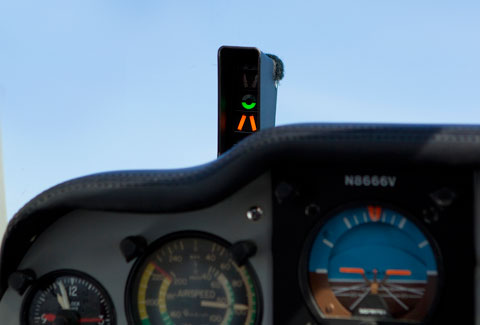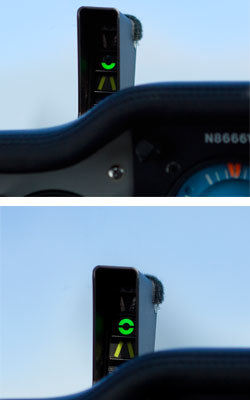Avionics: AOA for GA is OK by FAA
Installation considered a logbook entry

Angle of attack indicators have long been regarded as essential in military, corporate, and airline cockpits—and a recent FAA letter could speed the adoption of these potentially lifesaving systems in light general aviation airplanes, as well.
A variety of firms have developed AOA indicators, both FAA-certified and noncertified, for aircraft ranging from gliders to jets. But getting the FAA’s blessing to install noncertified equipment in Standard-category airplanes can be problematic. Some FAA inspectors consider the additions to be major alterations that require a Form 337, a frequently cumbersome, time-consuming, and expensive proposition. Others regard the lightweight sensors as minor and deem a logbook entry from an A&P mechanic as sufficient.
Now, in the case of Alpha Systems—a Minnesota firm that makes a variety of noncertified AOA systems—the FAA’s Small Airplane Directorate has ruled that the company’s AOA indicators are minor alterations that can be installed in Normal, Utility, Aerobatic, and Commuter aircraft with appropriate logbook entries. The Form 337 process isn’t required for the vast majority of installations.
“The Small Airplane Directorate views your system as non-required equipment that provides a safety benefit,” the agency said recently. “As such, the Small Airplane Directorate and the Flight Standards Service, Aircraft Maintenance Division has evaluated the installation of the Alpha Systems-AOA system on Normal, Utility, Acrobatic CAR 3 or Part 23 airplanes. We conclude the installation can be considered a minor alteration, provided the following provisions are met.”
The FAA requires the AOA systems be supplemental to existing stall warning systems, they can’t replace other instruments, and they must be independent from aircraft pitot-static systems. Also, AOA systems on pressurized aircraft are acceptable but must be evaluated on a case-by-case basis.
This caps a multiyear effort by Alpha Systems and air safety advocates who believe that AOA indicators and angle-of-attack education for pilots can help reduce stall/spin accidents. (Stall/spin accidents in the traffic pattern accounted for 7 percent of fatal GA accidents in the past 10 years, and losses of control while maneuvering made up 13 percent in the same period, according to the Air Safety Institute.)
Also, having the FAA spell out the conditions in which AOA indicators are judged minor alterations can be helpful to other AOA manufacturers. As long as their systems meet the same criteria, they should expect the same treatment.
 As the airplane slows on approach (top) it reaches its optimum AOA (above), signified by the green circle. By maintaining optimum AOA on approach, pilots avoid going too fast or too slow.
As the airplane slows on approach (top) it reaches its optimum AOA (above), signified by the green circle. By maintaining optimum AOA on approach, pilots avoid going too fast or too slow.
Fred Scott Jr., a Virginia pilot and safety advocate, had an Alpha Systems AOA indicator installed in his Beechcraft King Air and used it for a series of engineering flight tests to verify its accuracy. FAA officials and outside test pilots evaluated the noncertified AOA systems in his and other airplanes. Scott has been working to make AOA equipment more available and increase AOA education for pilots since several close friends were killed in a stall/spin accident (see “ Technique: AOA for GA,” June 2011 AOPA Pilot).
Companies that currently manufacture AOA systems for light GA aircraft include Advanced Flight Systems, Alpha Systems, Dynon, InAir Instruments, and Safe Flight Instrument Corp. Safe Flight’s AOA system is FAA certified, and other manufacturers have said they may seek certification in the future.
The theory behind the AOA indicators is well known and long settled. An airfoil always stalls at the same angle of attack, regardless of aircraft weight, air temperature, and humidity. By knowing how close airplanes are to the critical angle, pilots can fly more precise approaches and avoid inadvertent stalls. And automated voice callouts in AOA systems provide timely warnings of impending trouble.
Temporary blockages of aircraft pitot-static systems or airspeed indicator failures are less threatening in aircraft equipped with AOA indicators. And pilots flying in and out of short airstrips, or taking off or landing at high density altitudes, can use AOA indicators for optimal climb or approach speeds regardless of variations in atmospheric conditions or aircraft loading.
Pilots are taught to calculate approach speeds based on these variables. But the math gets complicated when airplanes are turning, climbing, or descending, and the center of gravity shifts during long flights. Pilots tend to err on the side of caution by padding the numbers, rounding up, and flying approaches too fast. The result is that pilots sometimes overshoot the base-to-final turn because of that excess speed, putting themselves at risk of a stall-spin accident; or they fly too fast on final, balloon in the flare, or simply aren’t able to stop on the runway.
The Air Safety Institute has long emphasized AOA education (see Essential Aerodynamics at www.airsafetyinstitute.org) and has evaluated numerous AOA systems for GA aircraft. AOA systems certified under the FAA’s most stringent Part 25 standards, such as those used for corporate jets, are prohibitively expensive for most GA aircraft owners. But noncertified systems typically range from $800 to $2,000—and they have been shown during an exhaustive series of tests to work accurately in a broad range of aircraft.
Tom Rosen, a board member for the American Bonanza Society and a retired airline pilot, said flying his Bonanza with an Alpha Systems AOA indicator that gives voice callouts is like having an attentive co-pilot in the right seat. “I can’t tell you how many times during my career that I called out hazardous situations to other crew members, or they did the same for me,” he said. “No matter how much experience you have, a second set of eyes is a safety benefit.”
Email the author at [email protected].


